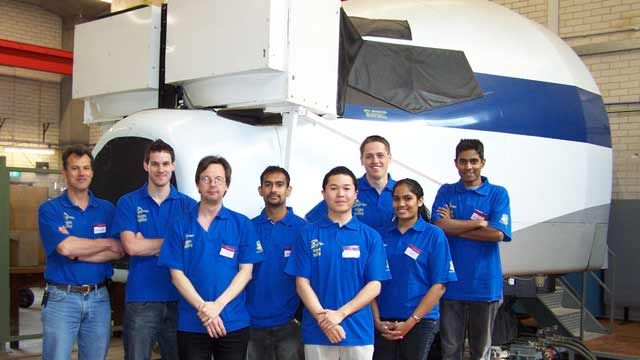University of Sydney Students Experience Flight Dynamics in the Variable Stability Flight Simulator
“The VSFS, which we built with MathWorks tools, enables engineering students to see and feel the direct effect of control design parameter changes on aircraft flight. That experiential component leads to major learning improvements for our students.”
Challenge
Solution
Results
- Deeper understanding of key concepts
- Career opportunities in leading organizations
- Accelerated development

Students in the University of Sydney’s School of Aerospace, Mechanical, and Mechatronic Engineering (SAMME) have a unique opportunity to experience the effects of design decisions on flight stability. Using a full-motion, three-degree-of-freedom flight simulator, they can feel how an aircraft responds to their controls under a range of environmental conditions, aircraft configurations, and control designs.
SAMME faculty and students built the Variable Stability Flight Simulator (VSFS) using the hydraulics, structure, and cockpit of a decommissioned QANTAS simulation trainer, replacing the original analog control system with a real-time system developed using MathWorks tools.
“With Simulink, the entire VSFS design is in a graphical format that is easy for students to understand,” says Dr. Peter Gibbens, senior lecturer at SAMME. “Simulink models also made it easy for us to architect and design the VSFS and then rapidly implement the system using Simulink Coder and Simulink Real-Time, which are effectively the core of the VSFS. Creating and prototyping control systems and observing their actual behavior is most effective with this setup.”
Challenge
While engineering students understood control systems theory, they lacked the intuitive feel for flight stability that comes from practical flying experience.
Gibbens and his colleagues at SAMME needed tools sophisticated enough to enable them to design and implement the real-time VSFS system yet intuitive enough for students to learn quickly. “For students to come up to speed takes way too long when using C,” Gibbens explains.
With more than 200 students in the undergraduate program, in addition to graduate students and faculty working on VSFS, the school needed access to tools from numerous workstations.
Solution
University of Sydney acquired a Campus-Wide License, enabling students and faculty to use MATLAB®, Simulink®, Simulink Coder™, and companion products campus-wide.
Gibbens and postgraduate student Alex Scamps used Simulink to design a control system model that took pilot yoke movements as input and drove the servo-actuators on the hydraulics to move the cockpit in response. After simulation, they used Simulink Coder to generate code, which they ran in real time using Simulink Real-Time™.
They used the same approach to develop VSFS modules for environmental conditions, such as turbulence, and for the aircraft itself, which included the complete equations of motion and the aerodynamic characteristics of the airplane.
SAMME faculty use the simulator to reinforce concepts taught in the classroom. In Flight Mechanics 1, for example, students use MATLAB to complete assignments on flight dynamics, aerodynamic effects on aircraft motion, flight stability, and aircraft modes of motion. Later in the course, they run aircraft simulations in the VSFS. As they perform maneuvers, instructors alter stiffness, damping, and other aerodynamic parameters to help students understand how these parameter changes affect handling.
For Flight Mechanics 2, students use MATLAB and Control System Toolbox™ to develop flight control systems and an autopilot system. Each instructor-approved control design is embedded into the VSFS. Students then fly a simulation to compare the performance and stability characteristics of their design with those of standard control designs.
Students who take Advanced Flight Mechanics learn the principles of flight test procedures. They use MATLAB and Signal Processing Toolbox™ to perform filtering and power spectrum analysis as they evaluate the characteristics of accelerometers and other test sensors. After simulating a flight test program and validating the aircraft model using regression techniques, they use Control System Toolbox to develop a flight control system and test it in the VSFS.
Many students use MathWorks products to complete their undergraduate and graduate thesis projects. These projects have included adding or improving models for the VSFS for Oblique Wing aircraft; lifting body aircraft, such as the NASA HL-10 and HL-20; and the F-16 fighter.
Results
Deeper understanding of key concepts. “With the VSFS, students can experience first-hand how changes to their Simulink models affect aircraft handling,” says Gibbens. “Based on tests given before and after time spent in the simulator, we see that flight simulation laboratory exercises improve student understanding of key concepts by 10 to 15%.”
Career opportunities in leading organizations. “Centered on experience with the VSFS and application of MathWorks products on relevant aerospace projects, our program produces quality graduates with advanced analytical and design skills,” says Gibbens. “Many of our engineering graduates have gone to work for organizations such as CAE, a leading aviation simulation company, and Australia’s Defence Science and Technology Organisation.”
Accelerated development. “With Simulink, you can look at the design and very quickly understand the system’s architecture and information flow, then in a matter of minutes, turn that design into real-time code,” says Gibbens. “You could develop systems directly in code, but you’d spend a thousand times as many hours doing so.”
Acknowledgements
University of Sydney is among the 1300 universities worldwide that provide campus-wide access to MATLAB and Simulink. With the Campus-Wide License, researchers, faculty, and students have access to a common configuration of products, at the latest release level, for use anywhere—in the classroom, at home, in the lab or in the field.